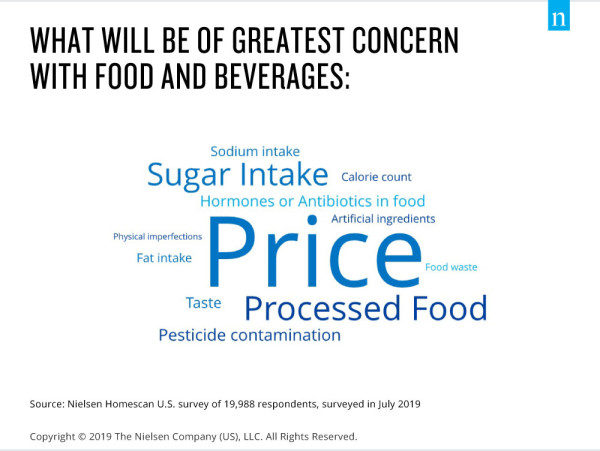Nielsen’s “How America Will Eat”report found that two-thirds of Americans say their eating habits have changed over the last five years, and three in 10 say they’re making more healthy food choices than they were a year ago; however, one-third of Americans say that they will prioritize price when it comes to what they consume over the next five years. This could be behind some other findings: 90% of households have purchased organic products, but only once per month; 86% have purchased sugar-free, but only once per month; 74% have purchased items categorized as excellent sources of protein, but they purchase these items not even once per month.
 People clearlywantto eat better, but there’s a gap between what theywantto do and what they areableto do, and Nielsen notes that this gap can be bridged one of two ways: “Price is the dominant driver of food purchases, unless [customers] are given other factors to consider…a sizable share of Americans are likely to base their food purchase decisions predominantly on price. The gap between intention and action for healthier eating boils down to how brands can force the consumer habit to consider health-oriented attributes, too.”
People clearlywantto eat better, but there’s a gap between what theywantto do and what they areableto do, and Nielsen notes that this gap can be bridged one of two ways: “Price is the dominant driver of food purchases, unless [customers] are given other factors to consider…a sizable share of Americans are likely to base their food purchase decisions predominantly on price. The gap between intention and action for healthier eating boils down to how brands can force the consumer habit to consider health-oriented attributes, too.”
Related: 5 Reasons to Embrace Private Label…and 5 Key Steps to Get Started Fresh Food Bolsters Brick-And-Mortar, According to Nielsen Report Grubhub Releases “Year in Food” Report, Top Trends
That last option—showing customers that it's not just price that matters—is shown best by private label brands, which don't always sell for less; sometimes, they sell by virtue of being "free-from" or through other better-for-you attributes. In terms of what consumersarebuying, Nielsen notes that beverages are big—and not necessarily as meal replacements: More so than many other reasons, three in 10 Americans say they are more likely to drink beverages “as a way to revive or sustain energy levels.” Beverages that meet desired needs have space to grow.
In terms of what consumersarebuying, Nielsen notes that beverages are big—and not necessarily as meal replacements: More so than many other reasons, three in 10 Americans say they are more likely to drink beverages “as a way to revive or sustain energy levels.” Beverages that meet desired needs have space to grow.Packaged frozen and shelf-stable produce, too, have a shot at growth: They cost, Nielsen says, nearly half as much per pound as the fresh equivalent, and can be stored, allowing busy families and families in food deserts to stock up.
Price also favors fresh meats including chicken, pork, and turkey, which are cheaper sources of protein than more convenient sources like jerky and nuts.
Another big trend: products that support mental health, whether through anxiety or sleep. “Brain foods” are worth the development time, as Nielsen’s numbers show.
 The release closes with this: “When it comes to the diet that many Americans have self-imposed, it’s the foods that will boost and not break these goals that will win by bridging the gap to healthier eating in America.” The report can be purchasedhere.
The release closes with this: “When it comes to the diet that many Americans have self-imposed, it’s the foods that will boost and not break these goals that will win by bridging the gap to healthier eating in America.” The report can be purchasedhere.









